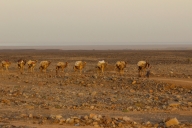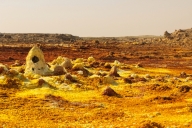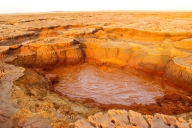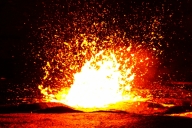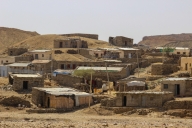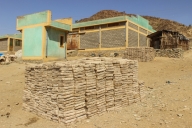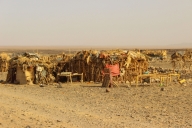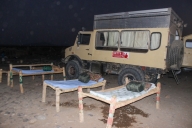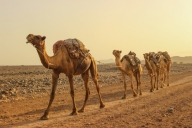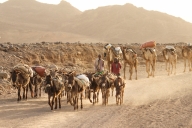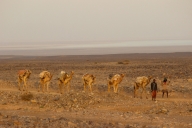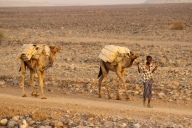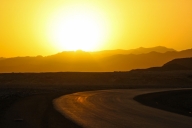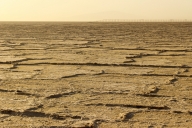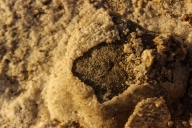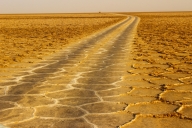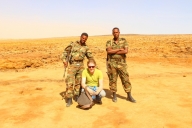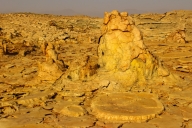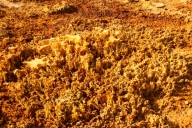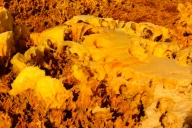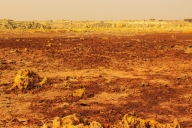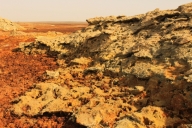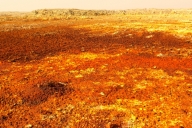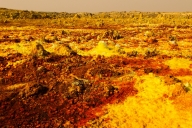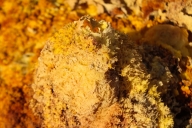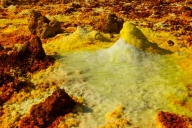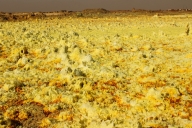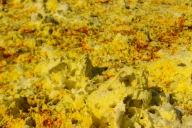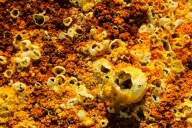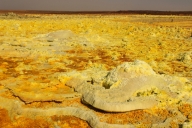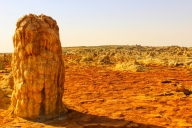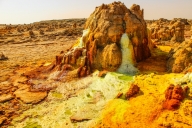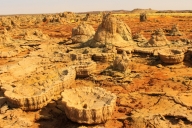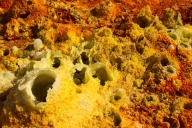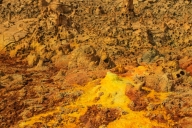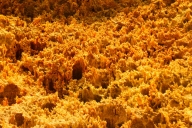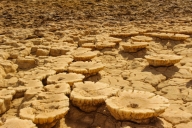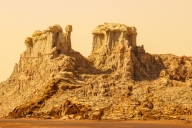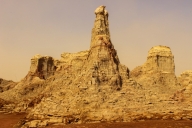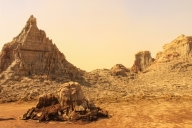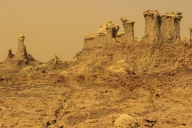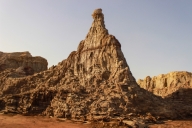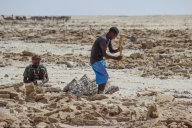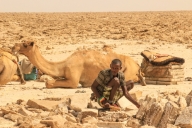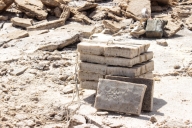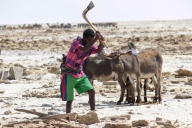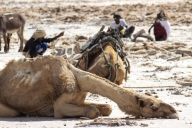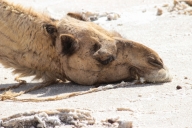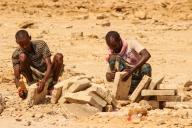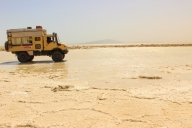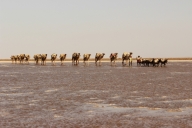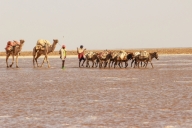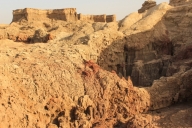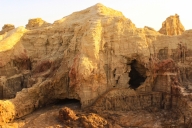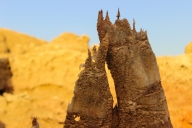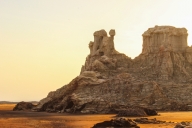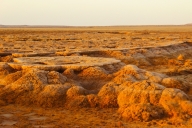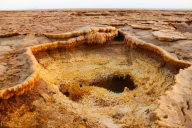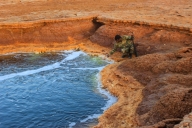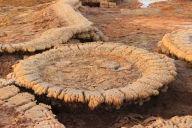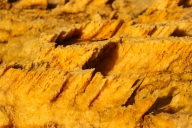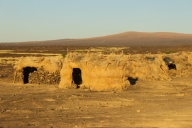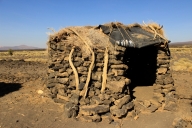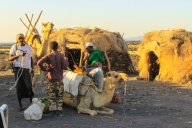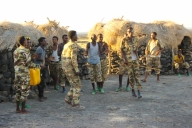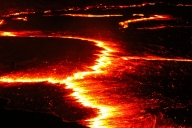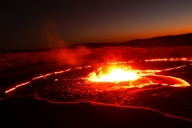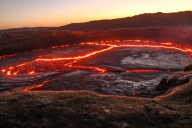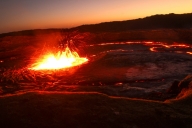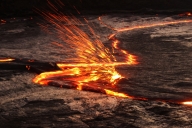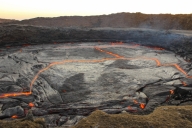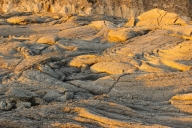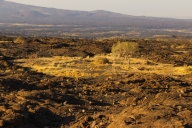Visited in January 2015.
With average annual temperatures of 34-35 degrees Celsius, the Danakil Depression close to the Eritrean border in Tigray, Northern Ethiopia is known as the hottest (barely) inhabited place on Earth. Arid and inhospitable as it is, this part of the country offers some of the most unforgettable and unique landscapes and experiences in the world. To give you some idea, imagine the Gates of Hell complete with a lake of fire, as a brightly colored lunar landscape. If this makes your imagination run wild – start packing your bags, this may be that one trip of a lifetime that all others will be measured against.
Here is a small preview of what you get to see when you come.
" slug="danakil-depression-preview-photos" order_by="sortorder" order_direction="ASC" returns="included" maximum_entity_count="500"]You can easily visit most places in Northern Ethiopia independently with a good guidebook. Not so, the Danakil. Think of a trip here as an expedition rather than a tour. The closest airport is over 120 km away in Mekele, Tigray’s capital, and while this is not very far, the roads in the area vary from bad to almost non-existent, so crossing even small distances by car can take hours, even with an experienced driver. You will need to bring everything with you from camping gear and bedding to food and water. Local guides must be hired (and are essential as drivers from another part of the country can easily get lost here), and starting a few years back – a military escort is also required, after 5 tourists were killed and several others kidnapped here in 2012. The Ethiopian government blames the incident on neighboring Eritrea, and has pretty much outlawed unescorted tourism in this part of the country.
Don’t let any of that scare you off. Several reliable tour operators and outfitter companies in Addis Ababa and Mekele offer great tours here and will take care of organizational aspects of your trip, leaving you to enjoy the spectacular scenery. My friends and I chose Getts Ethiopia for most of our itinerary in the country. Thanks to them, not only did we have a smooth trip, but also the best setup of all the visitors we saw in the area. It was an expensive option, but I can’t put a price on the availability of a hot shower in the middle of a dessert in the horn of Africa, and I would gladly recommend them for a trip to any part of Ethiopia, except for the Omo Valley, where you are better off getting a local guide.
Our tour of the Danakil followed a tour of the spectacular rock-hewn churches of Tigray and started with an early morning drive from the beautiful Gheralta Lodge to the Danakil’s gateway town of Berahile.
" slug="berahil-gateway-to-the-danakil-depression" order_by="sortorder" order_direction="ASC" returns="included" maximum_entity_count="500"]We stopped in Berahile to pick get our Danakil permits, local guide, cook and equipment truck, as well as our military escort. Our GETTS driver/guide actually took care of all these details, while we enjoyed some fantastic local coffee and a quick walk around town. There is not much to see in town, but it is an important stop on the salt caravan trails from Lake Assale and if your timing is right, you may get your first glimpse of this centuries-old industry, as the caravans come to unload just outside town.
Our next stop was just under two hours later in a small village called Hamed Ela. Populated by the local Afar tribe, this dirty and dusty, yet atmospheric village is used as base, from which most groups explore the two major sites of the Danakil – Dallol and Lake Assale, before moving on to the Erta Ale volcano. There are no toilets or showers here. Your group will be assigned a place to stay and given cots outside to sleep in. According to my guidebook it is possible to buy some basic food and lukewarm drinks from the locals, as well as rent a house for the night. We didn’t put this to the test, as we had a cook who made fantastic fresh meals and the only way to spend the night in a place like this is right under the stars.
" slug="danakil-depression-the-afar-kids-of-hamed-ale" order_by="sortorder" order_direction="ASC" returns="included" maximum_entity_count="500"]The Afar are a local nomadic pastoralist tribe, who practice Islam and were notorious for killing and castrating unwanted visitors as recently as the 1930s. They have since learned to profit from tourism, and tend to be welcoming and friendly, albeit more reserved than people in other parts of Ethiopia. We were instantly met by some curious local kids, who wanted to see what they could get from the faranji (foreigners). I borught a soccer ball for this very purpose. Unfortunately it was only one and I failed miserably to explain to the children that I wanted them to share the ball. Fortunately, one of the elders intervened and the ball ended up at the local school, where I hope all the kids got a chance to enjoy it.
" slug="salt-caravans-at-sunset-danakil-ethiopia" order_by="sortorder" order_direction="ASC" returns="included" maximum_entity_count="500"]By the time we finally arrived and settled at Hamed Ela, the day was quickly dwindling away and the only thing left to do before sunset was go see the salt caravans arriving from Mekele and setting off the other way. The salt trade has existed since the days of the Axum Empire, and the caravan routes followed today are the same as those used back in those days. The road to market takes two weeks and a bar of salt costing 1.25 birr locally, can be sold elsewhere for 12 birr. For perspective, at the time of our visit the exchange rate was about 19 birr per US Dollar.
According to local legend, once upon a time the land of the Danakil was made of gold and there was more gold here, than anywhere else in the world. Naturally, the people grew greedy, lazy and forgetful of God, so God in his anger turned the gold into salt. And one day, once the people have learned their lesson through hard labor, he may choose to turn the salt back into gold. This legend is sure to give some hope to the poor souls enduring the back-breaking labor of salt mining on the banks of Lake Assale.
" slug="danakil-depresson-driving-to-dallol-via-lake-assale" order_by="sortorder" order_direction="ASC" returns="included" maximum_entity_count="500"] The next morning we had an early start and set off for Dallol, about 20 minutes drive from Hamed Ela. At 116 meters below sea level this is not just the world’s hottest place, but also the lowest spot on land in Africa. The main attraction here is a fantastic-looking field of sulphurous hot springs, strange rock formations and eerily shaped vents and geysers discharging brine and acidic liquid. Some areas here are reminiscent of a coral reef, if one could be found on dry land, others – of big blocks of food-colored icing sugar. It’s not hard to imagine that you’ve somehow ended up on another planet. Just be sure to get here as early as possible, before the day heats up and while the morning light provides the best photo opportunities.
" slug="danakil-depression-dallol-landscape" order_by="sortorder" order_direction="ASC" returns="included" maximum_entity_count="500"] The name Dallol comes from the Afar language and means dissolution or disintegration. I’ve never been to Yellowstone National park, but my friend and travel companion who has, told me that its sights are as impressive, if not more so. However, just like Yellowstone this was not all the Danakil has to offer. And as you can see from the pictures above the number of visitors here is much smaller allowing you to feel like an explorer visiting a strange new world.
" slug="danakil-depression-dallol-rock-formations" order_by="sortorder" order_direction="ASC" returns="included" maximum_entity_count="500"]After a few of hours spent exploring Dallol we headed off back to Hamed Ale for lunch via Lake Assale, stopping at the salt mines on the lakeshore. It is a truly impressive sight with the Afar cameleers chipping away at the salty crust near the lakeshore to extract the neat rectangular salt bars we had seen the day before in Berahile their camels and donkeys by their side. By this point sun was beating down on us and we couldn’t help, but admire the workers busy with their labors all around us. The work looked so hard, you couldn’t help but wish for the Danakil land to be turned back into gold or something else of value, that would enable these people to trade for their salt.
" slug="danakil-depression-Lake-Assale-Salt-miners" order_by="sortorder" order_direction="ASC" returns="included" maximum_entity_count="500"]After lunch and a few hours avoiding the heat in the shade of our Hamed Ela camp, we headed back to Dallol to enjoy the sunset. On our way there we saw some of the salt miners start off on the way to market, their caravans fully loaded with the fruit of their labors. The caravans don’t spend the night at the saltpans, which are considered haunted by an evil jinn called Abo Lalu.
" slug="danakil-depression-salt-caravans-going-back" order_by="sortorder" order_direction="ASC" returns="included" maximum_entity_count="500"]Dallol is even more beautiful in the light of the setting sun. We went back to the higher part of the lakes, where the sulphurous springs and tectonic activity formed beautifully shaped columns and shapes, not unlike the fairy chimneys of Cappadocia. Even the soldiers in our military escort enjoyed the area, asking to have their pictures taken in front of the beautiful scenery.
" slug="afternoon-dallol-visit-and-sunset-over-lake-assale" order_by="sortorder" order_direction="ASC" returns="included" maximum_entity_count="500"] As we drove back from Dallol to Hamed Ela for the night, we saw one of the most beautiful sunset scenes, I’ve ever witnessed, as the sunlight reflected in the salty waters of Lake Assale, the view was just spectacular!
The next morning, we had an early start, said good-bye to Hamed Ela and headed off to Erta Ale Volcano, our last stop in the Danakil. The drive took most of the day, as the tract was pretty awful, sometimes going right on solidified lava flows. Finally, we arrived at a small village called El Dom, which hosts Erta Ale’s base camp of sorts – a ring of stone huts set up by the Afar as a starting point from which tour groups can ascend the volcano. After a quick meal our crew started packing camels for our hike up Erta Ale, while we checked out the surrounding area. The camels are necessary, as you have to bring all your camping gear and food with you. You can also hire a camel to ride up the volcano, but we opted to walk.
" slug="danakil-erta-ale-foothills" order_by="sortorder" order_direction="ASC" returns="included" maximum_entity_count="500"]Finally, we started our ascent at around 5PM. The hike up the volcano usually takes 3 to 4 hours, depending on how fit you are. It’s not at all steep and there is no climbing involved, but the road is pretty rough. Fortunately, in the late afternoon and early evening the heat is no longer a concern.
Finally we reached the summit and the caldera. What makes Erta Ale unique and the trip so worthwhile is that one of the two pit craters inside the caldera contains the world’s only permanent lava lake. The second one is now inactive, but can wake up at any moment. This is the lake of fire I mentioned above. It’s a spectacular sight, as you see the lava churning inside the lake, and then releasing small “eruptions” every few minutes. There is, of course, an element of danger to this, as a bigger eruption is always a possibility. Also, the be sure to try to avoid breathing in too much of the fumes, especially if you have respiratory issues. Breathing brimstone fumes in is neither pleasant nor good for you.
" slug="danakil-erta-ale-lava-lake" order_by="sortorder" order_direction="ASC" returns="included" maximum_entity_count="500"]After enjoying the view for a couple of hours we climbed out of the crater to the huts on the summit for the night. It can get pretty windy and chilly up there, so bring something warm and earplugs, if you’re a light sleeper. Also, there is a steep drop off to the caldera at the edge of the village, so be careful answering calls of nature at night. Tourists do sometimes die falling on the hard stone in the crater in the darkness.
Finally, we woke up for the sunrise and our last look at the volcano’s lake of fire, downed a quick breakfast and set off for Mekele. On the way down we took a last look at this beautiful landscape. I quietly wished for a chance to come back here. Maybe someday. I’ve certainly been thinking back on this trip a lot!
" slug="danakil-landscape-from-erta-ale" order_by="sortorder" order_direction="ASC" returns="included" maximum_entity_count="500"]

